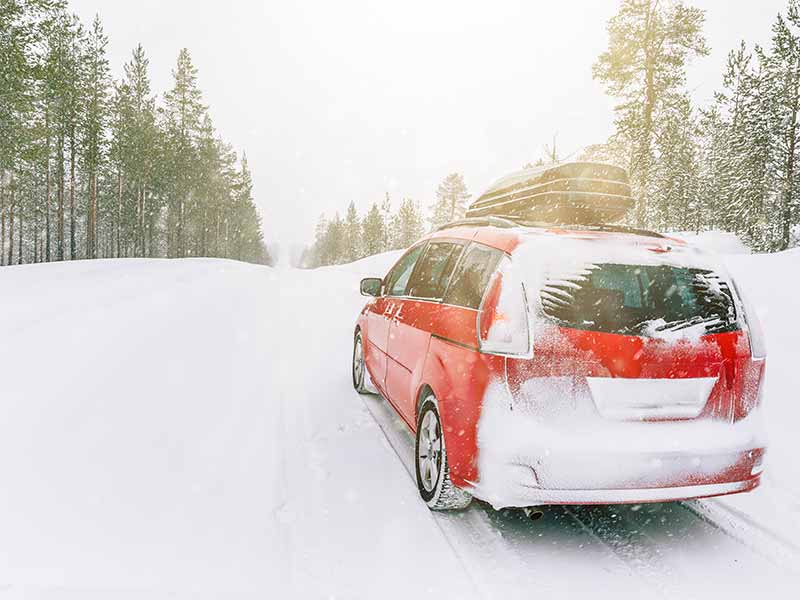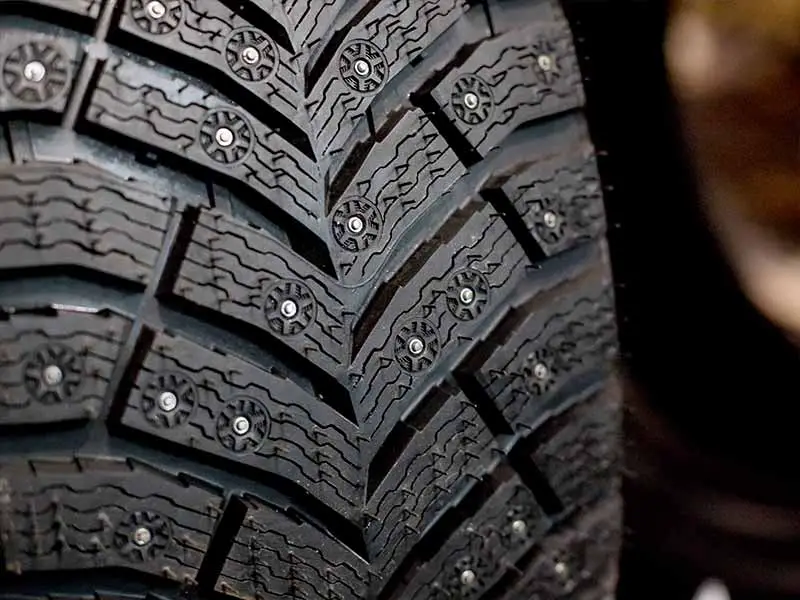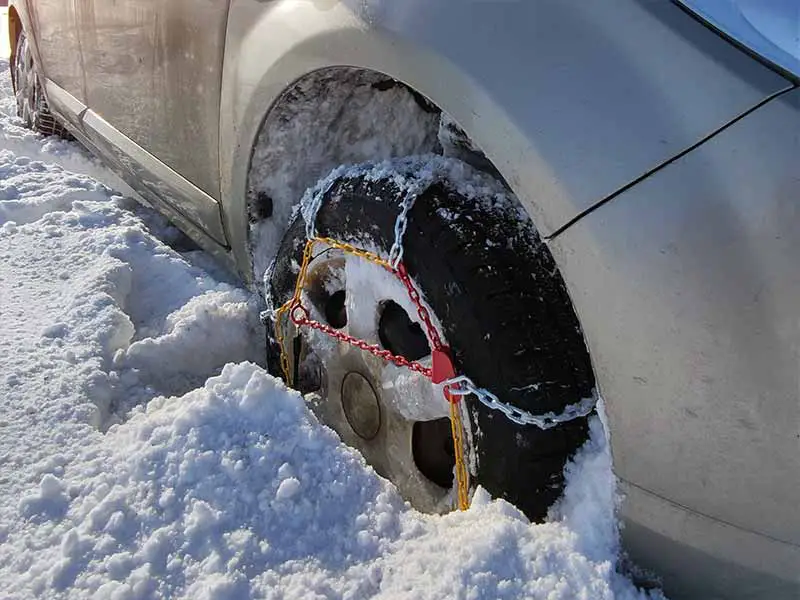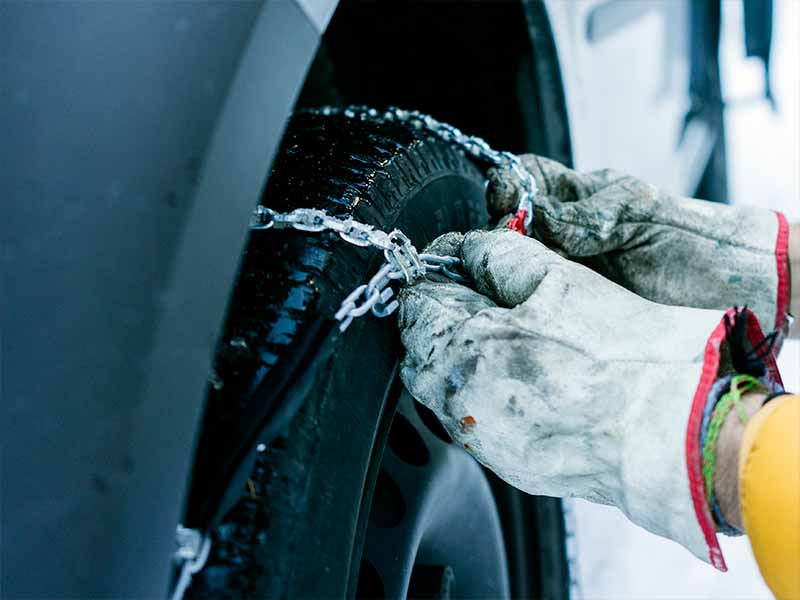When winter blankets the roads with snow and ice, choosing the right traction solution for your vehicle isn’t just a matter of convenience; it’s a crucial safety decision.
Whether you’re a daily commuter braving urban streets or someone facing the rugged challenges of rural winter driving, understanding the differences between studded tires and snow chains can be the key to a safer, more reliable winter driving experience.
Studded Tires Vs Chains
Studded tires provide superior traction on icy roads and are ideal for prolonged harsh winter conditions, whereas snow chains are best suited for occasional use in deep snow or emergency situations.
In this article, we explore the pros and cons of studded tires and snow chains, offering insights into their suitability for different winter conditions, vehicle types, and driving habits.

Understanding the Basics
I can’t overemphasize the importance of choosing the right type of tire or chain for your vehicle. It’s not just about comfort; it’s about safety and ensuring your vehicle performs optimally in various conditions.
Whether it’s the flexibility of winter tires or the robustness of studded tires and chains, each has its place in ensuring a safe and comfortable driving experience in winter conditions.
Different Types of Tires
Snow Tires and Winter Tires
- Snow Tires: These are specially designed for snow and ice. Their tread patterns and rubber compounds are optimized to perform in cold, snowy conditions. They offer improved traction compared to regular tires when you’re driving on snow-covered roads.
- Winter Tires: Similar to snow tires, winter tires are made for cold weather, but they’re also effective on wet and icy surfaces. They remain flexible in freezing temperatures, providing better grip and handling. Learn more about what are winter tires.
Summer Tires and All-Season Tires
- Summer Tires: These are ideal for warmer weather. They offer excellent dry and wet traction but are not suitable for winter conditions.
- All-Season Tires: As the name suggests, these tires are designed to handle a variety of road conditions, including light winter driving. However, they might not be the best choice in severe winter conditions.
Studded Tires and Tire Chains
Now, let’s talk about studded tires and tire chains, which are often used in harsh winter conditions.
- Studded Tires: These have metal studs embedded in the tread. They provide exceptional traction on icy roads. However, they can be damaging to road surfaces and are illegal in some areas during certain times of the year.
- Tire Chains: These are chains that you attach to your tires to increase traction in deep snow and ice. They’re great for occasional use in severe conditions but can be cumbersome to install. For more insights, check out snow tires vs chains.
When to Consider Each Type
Choosing the right tire or chain depends on your specific needs and driving conditions. Here’s a simple guide:
- Deep Snow and Ice: If you frequently drive in areas with deep snow or ice, studded tires or tire chains might be necessary. Remember, tire chains are more suitable for short-term use in deep snow. Find out how many inches of snow require chains.
- Cold, But Mostly Clear Roads: In areas where roads are often cold but clear of snow, winter tires are a better choice. They offer good performance without the road damage associated with studded tires.
- Mild Winter Conditions: For regions with mild winters, all-season tires might suffice, offering a balance between winter and summer performance.

Studded Tires
I recommend studded tires to those who face severe winter conditions regularly. However, it’s crucial to balance the need for safety with the potential drawbacks, such as road damage and legal restrictions.
For those who drive in mixed winter conditions, exploring other winter tire options might be more suitable.
What Are Studded Tires?
Studded tires are essentially winter tires equipped with metal studs. These studs provide additional traction by digging into ice, which can be a lifesaver on treacherous roads. They’re particularly useful in regions where roads are frequently covered in a layer of hard ice.
Pros of Studded Tires
- Enhanced Grip on Ice: The metal studs in these tires bite into ice, offering superior traction compared to regular winter tires. This can significantly reduce the risk of skidding and accidents on icy roads.
- Better Performance in Severe Winter Conditions: If you live in an area with severe winter conditions, studded tires can provide peace of mind by ensuring better control of your vehicle.
Cons of Studded Tires
- Road Damage and Legal Restrictions: One major downside is that these tires can damage road surfaces, especially when there’s no ice. Due to this, many places have legal restrictions on their use, limiting them to certain months or banning them altogether.
- Reduced Performance on Dry Pavement: On clear roads, studded tires can offer a less comfortable ride compared to regular winter tires. They can be noisier and may not handle as well on dry pavement.
When to Use Studded Tires
Choosing studded tires depends on your specific winter driving conditions. Here are some guidelines:
- Frequent Ice and Hard-Packed Snow: If you regularly drive on roads covered with hard-packed snow or ice, studded tires can offer the extra traction you need.
- Severe Winter Climates: In areas where winter is long and harsh, these tires can make a significant difference in driving safety.
Important Considerations
- Check Local Laws: Always check your local laws regarding studded tires. Their use is restricted or banned in some areas.
- Road Conditions: Consider the typical road conditions you encounter during winter. If you rarely drive on icy roads, the cons of studded tires might outweigh the pros.

Snow Chains
I recommend snow chains for drivers who face occasional heavy snowfall or need a backup option for unexpected winter weather.
They are a cost-effective and versatile solution for enhancing safety in snowy conditions. However, for regular winter driving, especially on mixed road conditions, other tire options might be more practical.
Let’s explore what snow chains are and weigh their advantages and disadvantages.
What Are Snow Chains?
Snow chains are exactly what they sound like – chains that you attach to the tires of your vehicle. They’re designed to provide increased traction when driving on snow and ice. They’re particularly useful for navigating deep snow, where tires alone might not provide sufficient grip.
Pros of Snow Chains
- Versatility: One of the biggest advantages of snow chains is their versatility. You can attach them to your tires when needed and remove them when conditions improve. This adaptability is particularly useful in areas where snowfall is unpredictable.
- Effective in Deep Snow and Packed Snow: Snow chains excel in deep snow conditions. They provide the necessary grip to prevent your vehicle from getting stuck and ensure safe navigation through challenging snowy terrains.
Cons of Snow Chains
- Installation Inconvenience: Unlike studded tires, which are ready to go once installed, snow chains require manual installation. This can be cumbersome, especially in cold and snowy conditions.
- Limited Speed and Comfort: When using snow chains, you need to drive at lower speeds to ensure safety and prevent damage to the vehicle. They also make the ride less comfortable due to increased vibration and noise.
When to Use Snow Chains
Deciding when to use snow chains depends on your specific situation. Here are some guidelines:
- Occasional Severe Snow Conditions: If you encounter deep snow occasionally, snow chains are a practical choice. They can be stored in your vehicle and used only when necessary.
- Emergency Situations: Snow chains are also great for emergency situations where you might get caught in unexpected snowfall.
Important Considerations
- Vehicle Compatibility: Ensure that your vehicle is suitable for snow chains. Some cars have limited clearance between the tire and the vehicle body, which might not accommodate chains.
- Driving Speed: Remember, when using snow chains, it’s important to drive slowly to avoid damaging your vehicle and ensure safety.

Studded Tires Vs Snow Chains
In my opinion, the choice between studded tires and snow chains largely depends on the typical winter conditions you encounter and your vehicle type. For those living in regions with severe and consistent winter conditions, studded tires are a reliable choice.
However, if you experience occasional heavy snowfall or need a flexible solution for changing conditions, snow chains are a practical and cost-effective option.
Suitability for Different Conditions
Studded Tires
- Best for Consistent Winter Conditions: Studded tires are ideal for areas with prolonged periods of icy roads and extreme winter conditions.
- Performance on Ice and Hard-Packed Snow: They offer unparalleled traction on ice and hard-packed snow, reducing the risk of skidding.
Snow Chains
- Ideal for Occasional Deep Snow: Snow chains are more suited for occasional use, especially in deep snow or emergency situations.
- Versatility for Changing Conditions: They can be put on and taken off as needed, making them versatile for fluctuating winter conditions.
Vehicle Compatibility
- Studded Tires: Suitable for most vehicles, but check local regulations as some areas restrict their use.
- Snow Chains: Not all vehicles have the necessary clearance for chains, so it’s important to check your vehicle’s compatibility.
Considerations for Long Winter Use
- Wear and Tear: Studded tires can wear down over time, especially if used on dry roads. Snow chains also have a limited lifespan and can damage the road if used incorrectly.
- Driving Comfort: Studded tires can be noisy on dry roads, while snow chains can significantly reduce driving speed and comfort.
All-Wheel Drive (AWD) Vehicles
- Studded Tires: Even AWD vehicles benefit from the enhanced ice traction of studded tires.
- Snow Chains: For AWD vehicles, chains should be used on all four wheels to maintain balance and performance.
Safety and Legal Considerations
It’s important to be aware of and comply with local laws and regulations regarding studded tires and snow chains. Safety should always be the top priority.
Studded tires are excellent for consistent icy conditions but may not be legal or necessary in all regions. Snow chains, on the other hand, are a great emergency tool for deep snow conditions but require careful handling and adherence to speed limitations.
Safety Aspects
Studded Tires
- Enhanced Traction on Ice: Studded tires provide excellent grip on icy surfaces, reducing the risk of accidents in severe winter conditions.
- Potential Road Damage: However, they can cause excessive wear on dry roads and may be less effective on wet or slushy surfaces.
Snow Chains
- Superior Grip in Deep Snow: Snow chains offer unmatched traction in deep snow, significantly improving vehicle control.
- Driving Limitations: They require careful driving at reduced speeds and can affect the overall handling of the vehicle.
Legal Restrictions and Guidelines
Studded Tires
- Regional Restrictions: Many regions have specific laws regarding the use of studded tires, often limiting their use to certain months or outright banning them due to road damage concerns.
- Mandatory in Some Areas: In contrast, some snowy regions mandate the use of studded tires during winter months for safety.
Snow Chains
- Required in Certain Conditions: Some areas, particularly mountainous regions, require snow chains under certain winter conditions.
- Usage Limitations: There are also regulations on where and how you can use snow chains, often related to the depth of snow or type of vehicle.

Cost and Longevity
If you live in an area with severe and consistent winter conditions, investing in studded tires might be more cost-effective in the long run. However, for those who encounter occasional heavy snowfall or want a backup option for emergencies, snow chains are a more budget-friendly choice.
Remember, the right decision not only ensures safety but also aligns with your specific driving needs and conditions. Let’s delve into the financial aspects of studded tires versus snow chains.
Initial and Long-Term Costs
Studded Tires
- Initial Cost: Studded tires are generally more expensive than regular winter tires due to the added cost of the metal studs.
- Maintenance and Replacement: They also require regular maintenance, and the studs can wear down over time, especially if driven on dry roads, leading to additional costs.
Snow Chains
- Lower Initial Investment: Snow chains are typically less expensive than a set of studded tires.
- Durability and Replacement Costs: While they can last several seasons if used and stored properly, chains can break and may need occasional replacement.
Durability and Maintenance
Studded Tires
- Wear and Tear: The lifespan of studded tires depends on how often they’re used on non-icy surfaces. Driving on dry or wet roads can significantly shorten their lifespan.
- Seasonal Use: To maximize their lifespan, studded tires should be used only during the winter months and stored properly during the off-season.
Snow Chains
- Careful Use and Storage: The longevity of snow chains depends on careful use and proper storage. They should be cleaned and dried before storage to prevent rust and damage.
- Occasional Use: Since chains are typically used only in deep snow conditions, they can last longer if they’re not overused.
Saving Money While Ensuring Safety
- Choose Based on Need: To save money, choose the option that best fits your typical winter driving conditions. Over-preparing can lead to unnecessary expenses.
- Quality Matters: Investing in good quality studded tires or chains can save money in the long run, as they will likely last longer and perform better.
- Proper Maintenance: Regular maintenance and proper storage can extend the life of both studded tires and snow chains, preventing the need for early replacement.

Making the Right Choice
While studded tires offer unmatched performance in icy conditions, they come with higher costs and legal restrictions.
Snow chains, on the other hand, offer flexibility and are a cost-effective solution for occasional use in deep snow.
Let’s consider the key factors to guide your decision.
Factors to Consider
Driving Conditions
- Severity of Winter: If you’re in an area with long, harsh winters and frequent icy roads, studded tires might be your best bet.
- Occasional Snowfall: For those who experience occasional heavy snowfall, snow chains can be a more practical and economical choice.
Vehicle Type
- Compatibility: Ensure that your vehicle is compatible with either studded tires or snow chains. Some vehicles, especially those with low clearance, might not be suitable for chains.
- All-Wheel Drive (AWD): For AWD vehicles, studded tires can provide uniform traction, while chains should be used on all four wheels if chosen.
Personal Driving Habits
- Frequency of Winter Driving: If you frequently drive in winter conditions, studded tires offer convenience and consistent performance.
- Emergency Preparedness: For those who drive less frequently in winter conditions, keeping snow chains in your vehicle can be a wise emergency precaution.
Legal and Safety Considerations
- Local Regulations: Always check and adhere to local laws regarding the use of studded tires or snow chains.
- Safety Priority: Regardless of your choice, prioritize safety by ensuring proper installation and usage.
Recommendations Based on Conditions
- Urban Driving with Occasional Snow: Snow chains can be more suitable, as they can be used as needed and are easier to store when not in use.
- Rural or Mountainous Areas with Severe Winters: Studded tires are often the better choice for consistent performance and safety.
Resources
Below are some links you may find helpful when learning about tires:
- Winter driving tips – National Highway Traffic Safety Administration
- How to choose winter tires – Consumer Reports
Final Thoughts
Studded tires are a solid investment for those facing consistent, icy road conditions, offering unmatched traction and safety. On the other hand, snow chains are a flexible and cost-effective solution for drivers who encounter occasional heavy snowfall or need a reliable emergency option.
Remember, the right choice not only enhances your driving experience but also ensures your safety and that of others on the road. By considering factors such as local weather patterns, vehicle compatibility, and legal requirements, you can make an informed decision that suits your winter driving needs.
Good luck and happy motoring.





